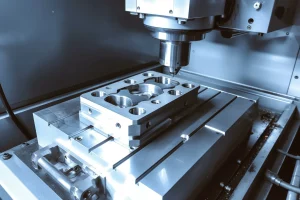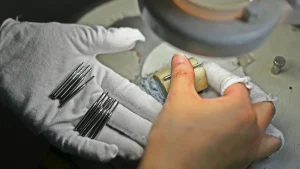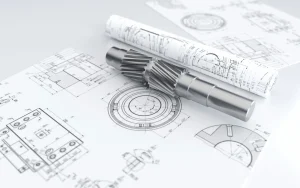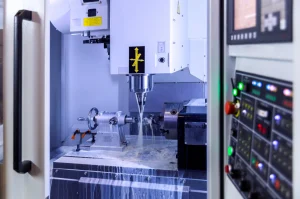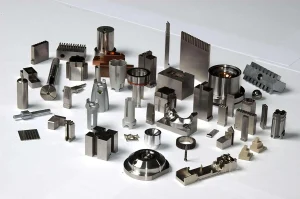在精密制造领域, CNC加工服务以其卓越的精度成为现代工业的基石, 一致性, 和灵活性. 然而, an often underestimated yet crucial aspect
–
材料选择
–
directly determines the success or failure of the final product. Choosing the right material is not only related to the strength, life and function of the parts, but also closely related to processing efficiency and cost control. This article will delve into the world of materials commonly used in CNC machining to help you make informed decisions.
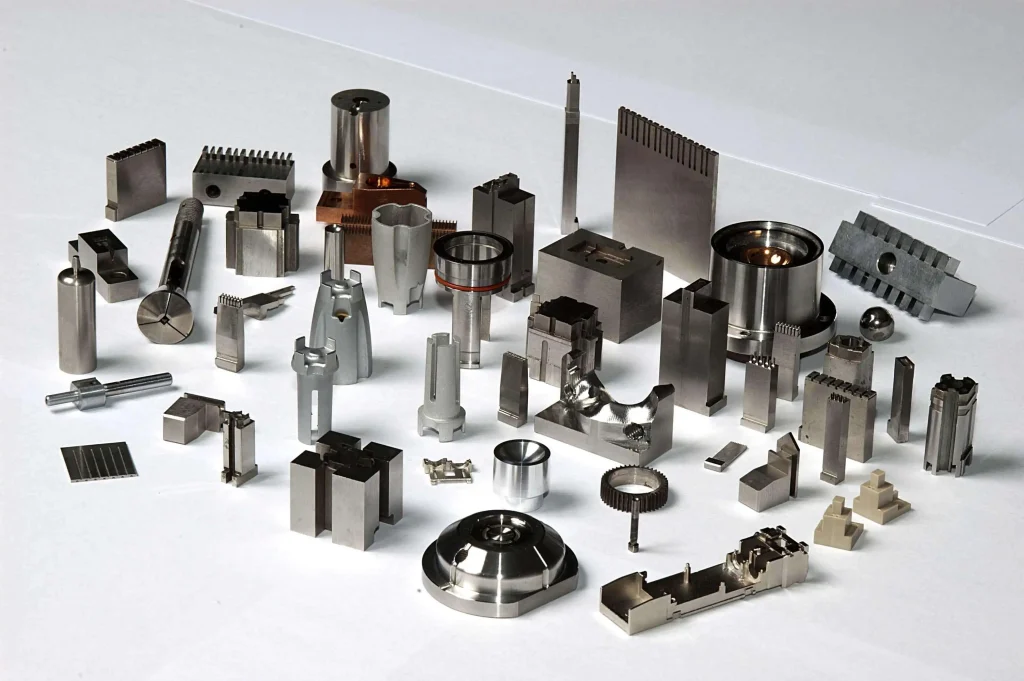
1. Metal Materials: The Workhorse of Strength and Durability
1. Aluminum Alloy:
Representatives: 6061, 7075, 2024.
优点: Lightweight and high strength, excellent machinability (low cutting resistance, smooth chip evacuation), good thermal conductivity, 耐腐蚀性 (especially after anodizing), relatively low cost.
应用领域: Aerospace structural parts, 汽车零部件 (wheel hubs, engine mounts), consumer electronics enclosures, precision instrument frames, robotic components. 6061 is the well-deserved “all-round king”, 和 7075 offers higher strength.
2. 钢:
Representative:
Mild steel (例如. 1018, A36): Easy to machine, 低成本, good weldability, but average strength and hardness.
Medium carbon steel (例如。, 1045): Balanced strength, hardness and toughness, heat treated (quenched and tempered) can significantly improve performance.
合金钢 (例如 4140, 4340): 高强度, 高韧性, excellent wear resistance and fatigue resistance, often require heat treatment.
不锈钢 (例如。, 303, 304, 316, 17-4 PH): Excellent corrosion resistance and aesthetics. 303 is easy to cut (contains sulfur), 304/316 is versatile but slightly difficult to process (easy to stick knives, work hardening), 和 17-4 PH can achieve high strength through age hardening.
应用领域: 工具, 模具, 轴, 齿轮, high-strength structural parts, food and medical equipment, chemical equipment parts, marine environmental components. Stainless steel is particularly suitable for scenarios where corrosion or hygiene requirements are present.
3. 黄铜:
优点: Excellent machinability, beautiful golden color, good electrical and thermal conductivity, 耐腐蚀性 (especially water resistance), 戴阻力, antibacterial properties.
应用领域: Valves, pipe fittings, decorative parts, musical instrument components, electrical connections, parts requiring low friction and corrosion resistance.
2. 工程塑料: Lightweight and Special Performance Selection
1. 聚甲醛 (聚甲醛, Delrin):
优点: 高强度, high rigidity, excellent dimensional stability, low friction coefficient, good wear resistance, chemical solvent resistance.
Machining Note: It is easy to generate internal stress, so pay attention to the sharpness of the tool and cutting parameters to avoid overheating leading to deformation or release of formaldehyde.
应用领域: Precision gears, 轴承, 衬套, snaps, tool handles, sliding parts that require high rigidity and low friction.
2. 尼龙 (PA6, PA66, with glass fiber reinforced):
优点: 良好的韧性, excellent wear resistance, self-lubrication, good chemical resistance, and excellent electrical insulation. Glass fiber reinforcement greatly improves strength, stiffness and heat resistance.
Processing Note: Strong hygroscopicity, must be fully dried before processing; It is easy to produce burrs during processing; Materials containing glass fiber have great wear on the tool.
应用领域: 齿轮, 轴承, pulleys, wear-resistant gaskets, structural brackets, electrical insulation.
3. 窥视 (Polyether Ether Ketone):
优点: Top engineering plastics! Extremely high strength, rigidity, 耐热性 (long-term use > 250℃), excellent chemical resistance, very low creep, flame retardancy, good wear resistance and dimensional stability.
Machining Note: The material cost is high and the processing is difficult (high rigidity machine tools, sharp carbide or PCD tools, and reasonable parameters to control temperature and stress).
应用领域: 航天, high-end automotive (engine peripherals), oil and gas (corrosion-resistant seals), medical implants and devices, semiconductor manufacturing equipment components.
3. 复合材料: Future Stars with Designable Performance
Stands for: Carbon Fiber Reinforced Polymer (CFRP), Glass Fiber Reinforced Polymer (玻璃钢).
优点: Extremely high specific strength (strength/density) and specific stiffness (modulus/density), strong designability, and good fatigue resistance.
Machining Challenge: Extremely significant! Anisotropy leads to complex processing forces, which are prone to delamination, 毛刺, and tears. severe wear on the tool (special diamond-coated tools are required); Harmful dust needs to be strictly protected.
应用领域: Aerospace main load-bearing structures, high-performance automobile bodies/chassis, 运动器材 (bicycle rackets, rackets), and robot lightweight arms.
How to choose the best material for your CNC project?
With a wide range of options, think about the following core questions:
1. Functional Requirements:
Strength and Rigidity: How much load does the part need to withstand? Is it prone to deformation? (铝合金, 钢, 窥视, nylon with fiber)
Abrasion Resistance: Is there any sliding friction? (聚甲醛, 尼龙, Fiber-containing materials, some steel)
耐温性: What is the operating environment temperature range? (High temperature selection of PEEK and special alloys; Considering material brittleness at low temperature)
耐腐蚀: What media is it exposed to? (Water, Chemicals, Salt Spray – 不锈钢, 黄铜, 窥视, Specific Plastics)
Conductive/Insulating: Is conductivity or insulation required? (Metals conduct electricity, plastics are usually insulated)
Weight: Is lightweight key? (Aluminum alloys, 钛合金, engineering plastics, composite materials)
Appearance and Texture: Surface Treatment Requirements? (Metal is easy to plate/oxidize, plastic can be dyed)
2. Manufacturing Feasibility:
Machinability: Is the material easy to cut? What about tool wear? (铝合金, 黄铜, POM are easy to process; 不锈钢, 钛合金, 窥视, composite materials are difficult to process)
Dimensional stability: Is it prone to deformation after machining? (POM and PEEK have good stability; nylon moisture absorption and easy deformation; Thin-walled parts need to be noted)
Post-processing needs: Do you need heat treatment, 表面处理 (阳极氧化, 电镀, 喷砂, 等)? This affects material selection and cost.
3. 成本考虑:
Material costs: Raw material prices vary significantly (例如。, regular aluminum vs titanium vs PEEK).
Machining Costs: Difficult-to-machine materials require slower cutting speeds, more frequent tool changes, and higher equipment requirements, significantly increasing labor costs.
Total cost of ownership (TCO): Consideration of material costs, processing costs, post-processing fees, and replacement/repair costs due to insufficient performance.
结语:
In the world of CNC machining, materials are by no means a supporting role, but the core protagonist that jointly composes product performance with the processing process. Understanding the key properties, processing characteristics, and applicable scenarios of common metals (铝, 钢, 不锈钢, 黄铜), engineering plastics (聚甲醛, 尼龙, 窥视) and composites is the foundation for success. Smart material selection stems from a precise trade-off between functional requirements, manufacturing feasibility, 和成本效益. When you start your next CNC project, take the time to dive into material options with your CNC machining service provider, which is often a critical step towards high-performance, reliable and cost-effective products. 记住, the most expensive material is not necessarily the best, the most suitable is the best choice.

